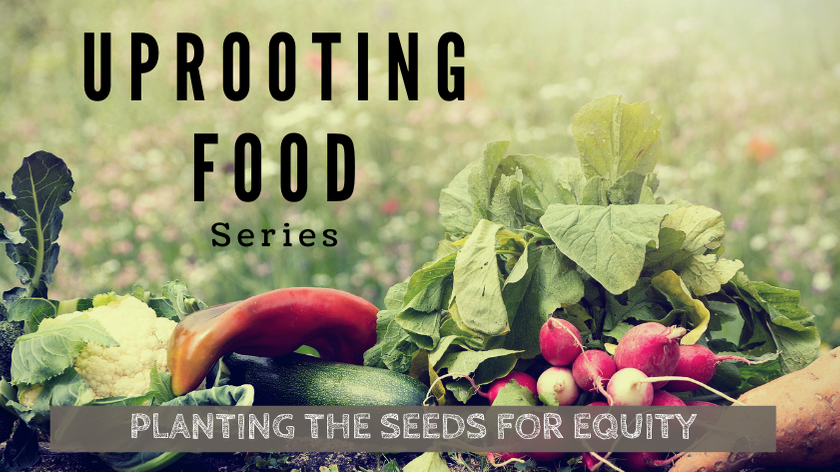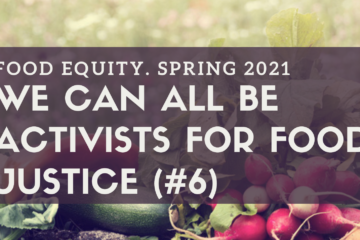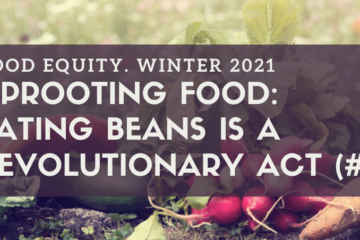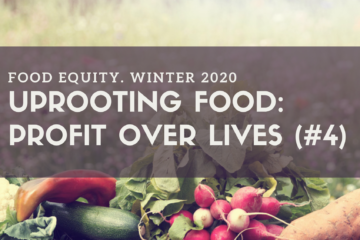
Andrea is embarrassed. Her husband works full time and she works part time because her two children are young and yet here she stands, again, wearing her mask in line at the food bank. She hopes for some apples because they might stay fresh through the week.
Food desert, food injustice, food insecurity—so many words to say: some people are left feeling hungry. The problem is easy to describe with numbers and statistics that show inequities. The problem is harder to understand when the numbers have faces, the faces that are growing in numbers as the economy reels from the pandemic.
Because our country is in crisis we are looking toward emergency responses. We will either temporarily boost our usual systems or we will cobble something together to get us through. Or we will use this as an opportunity to learn from our history and proactively plan for a new approach that addresses the underlying issues of society, politics, economics and health.
Adequate food and nutrition are a human right. Our systems will be held accountable as we begin to see hunger as a symptom of injustice.
First, some definitions:
Food insecurity—without reliable access to enough nutritional food.
Food desert—a living area where nutritional, especially fresh, food is not available.
Food injustice—the systemic issues behind hunger.
None of these phrases accurately describe the whole picture, but they are a starting point in working towards understanding the whole picture.
And now, some history. The traditional public and private efforts to address hunger are food banks, SNAP (Supplemental Nutrition Assistance Program, formerly the Food Stamp program), WIC (pregnant women and young children) and school meals for children. Unfortunately, none of them have kept pace with the changing economy and none were ready for new burdens due to this pandemic.
Food Banking is a system where surplus and donated food is “banked” and then easily distributed to those in need. While food banks have met and continue to meet immediate needs, have they inadvertently slipped into keeping the problem under cover? With emotional appeals for donations, have they misled the “haves” into thinking they have done their part? Are recipients left feeling, and being, powerless as victims of class-ism?
Since 1939 the original Food Stamp Program has morphed many times into what we know now as the current SNAP program. Run through the USDA, (Federal Department of Agriculture) changes depend on federal administration and legislation at that given time and are implemented by each state. The number of people using the program has increased yet benefit levels have not kept pace with the economic data.
There are efforts due to the pandemic to increase and improve availability of benefits through stimulus packages and response acts. But we are seeing how difficult it is for the unyielding system to be responsive to changing needs and changing economics. We cannot let these temporary measures stay temporary.
Pre-COVID, despite being employed, more than 20% of all Latinos were food insecure compared to just 10% of all Americans and nearly 25% of all Latino children lived in a food-insecure household. SNAP does not provide the expected relief. Latinos are underserved by SNAP even though many are eligible. Many are ineligible due to their immigration status even though they pay taxes. They are the working poor. Our country’s essential workers. Working to sustain our food supply.
Giving people food is not a true measure of success. The very act of “giving” underlines a profound power imbalance. Food injustice reflects the social injustice seen in inadequate wages, unemployment, health inequity, political classism, and structural racism.
Yes, the existing social determinants are complex. Yes, the food production and distribution structures are formidable powers. Food justice cannot happen until people have power over how they get their food and until we widen our views, challenge our systems, and hold ourselves accountable.
This series will continue to look at the current systems of agriculture, food production, capitalism, structural racism and what it will take to move towards a system built on the foundations of food equity.
What’s Needed Now
1- Start having meaningful conversations with family and friends about the need for long term solutions to food insecurity which include livable wages and healthcare for all.
2- Spread the word: Double-Up Bucks give extra benefits for buying fresh, healthy foods at Farmers Markets. Does your state offer this? What about states where family and friends live?
3- Contact your U.S. senators and ask them to vote YES on the HEROES Act to strengthen SNAP for families and kids in need. This bill increases SNAP benefits for kids and struggling families and strengthens child nutrition programs, ensuring children continue to get the food they need during this crisis.
References
- https://salud-america.org/?s=insecurity
- https://www.fns.usda.gov/snap/short-history-snap#1977
- https://www.feedingamerica.org/sites/default/files/research/latino-hunger-research/low-income-hispanic-children.pdf
- https://www.hamiltonproject.org/blog/the_covid_19_crisis_has_already_left_too_many_children_hungry_in_america?referringSource=articleShare
- https://whyhunger.org/how-we-work/
Informative Resources
- https://whyhunger.org/images/publications/Special-Report.pdf
- https://www.citylab.com/solutions/2017/06/why-cant-america-solve-the-hunger-problem/530151/
- https://www.nytimes.com/2020/04/08/business/economy/coronavirus-food-banks.html
- https://www.theatlantic.com/ideas/archive/2020/05/food-banks-cant-go-like/611206/


